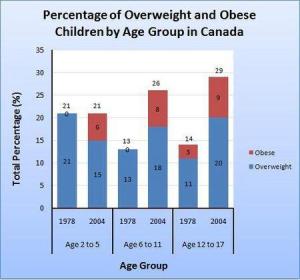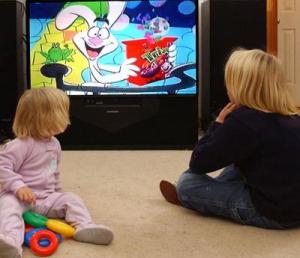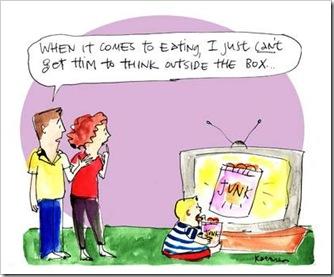Posts filed under ‘1’
Let’s leave food out of this for a second…
As important as I think it is to talk about the implications of child-centered advertising on eating behaviour, I also want to discuss the implications it can have on self esteem and body image. Children’s Mental Health Ontario suggests that 1 in every 100 to 200 adolescent girls in Ontario suffers from anorexia nervosa. Similarly, 1 to 3 in every 100 suffers from bulimia [1]. These prevalences have sadly been on the rise over the past few decades. What’s worse? In today’s society, more children under the age of 12 years have been diagnosed with showing signs of these life-altering eating disorders. My belief is that the media plays a large role in this.
Take into consideration the Pepsi commercials with Britney Spears. Now here’s what I call a double whammy. Not only do these commercials promote an unhealthy drink, but they also do so in a rather provocative manner. In these commercials Britney is wearing little clothing, dancing (often inappropriately for young viewers), and looking thin and dolled-up. And there are a lot more commercials like this. For decades the media has been influencing our youth to think that they need to be thin, pretty, and wearing designer clothes to fit in with today’s society. As a consequence, “children at a very young age are already striving to attain society’s unattainable ‘ideal’ body image [2].”
 I’ve always wondered why we rarely see average-sized women as models, in commercial ads, etc. If I can’t come to terms with this, how is a child to? Moreover, have you ever seen a doll or a kids toy that wasn’t thin? Think about all of the Barbie dolls – they are all thin, extremely thin. What kind of message is this sending? What is so wrong with having a Barbie doll who is a little overweight? I understand that overweight and obesity rates are too high, but I don’t think having an average-sized doll would make this problem any worse. If anything, I think it might be a nice change of pace, and hopefully even give some sense of belonging to a child who is struggling with their weight.
I’ve always wondered why we rarely see average-sized women as models, in commercial ads, etc. If I can’t come to terms with this, how is a child to? Moreover, have you ever seen a doll or a kids toy that wasn’t thin? Think about all of the Barbie dolls – they are all thin, extremely thin. What kind of message is this sending? What is so wrong with having a Barbie doll who is a little overweight? I understand that overweight and obesity rates are too high, but I don’t think having an average-sized doll would make this problem any worse. If anything, I think it might be a nice change of pace, and hopefully even give some sense of belonging to a child who is struggling with their weight.
As I mentioned in a reply to one of my readers, Dove has done an excellent job of promoting that beauty is more than appearance. Their Campaign for Real Beauty [3] has received a lot of attention and good reviews. I also think it has brought light to the image the media can hold over children of what ‘perfection’ is.
I think if more companies and corporations would follow Dove’s lead, less children would feel so negatively about themselves. Any opinions about this?
Works Cited
[1] Eating Disorders in Children and Adolescents. Children’s Mental Health Ontario. Accessed online at http://www.kidsmentalhealth.ca/get_help/eating.php
[2] Thompson, Colleen. (2009). Anorexia and Bulimia help. Eating Disorders Mirror Mirror. Accessed online at http://www.mirror-mirror.org/child.htm
[3] Dove’s Campaign for Real Beauty. Accessed online at http://www.campaignforrealbeauty.com/
Commercial time vs. actual show time
 In response to Allison’s comment, I decided to try and find an estimate of commercial time versus actual show time. Unfortunately, it was harder than I thought and the numbers I found varied from one another. None the less, here are some interesting statistics I came across:
In response to Allison’s comment, I decided to try and find an estimate of commercial time versus actual show time. Unfortunately, it was harder than I thought and the numbers I found varied from one another. None the less, here are some interesting statistics I came across:
- children networks have 76 % more food-related commercials per hour than other television networks
- the Saturday morning 7-10 AM time slot is the most saturated with food-related commercials targeting children and young adolescents
- Spain’s Audiovisual General Law allows for 29 minutes of advertisements per hour
- the average Canadian watched 25,000 commercials in 2008
- in the 1960’s, a typical hour-long show viewed in the US was about 51 minutes, leaving only 9 minutes of commercials
- an hour-long show today is typically only 42 minutes long, allowing for 18 minutes of commercials
From the above statistics, it appears that the time allotted for ‘show time’ has decreased over the past few decades. In response, the time allotted for commercials in an hour-long show has doubled. I was curious whether or not the above statistics were true, so I tested it out. I turned on the television, stared at it for an hour, and timed each commercial. In the 60 minutes I sat there, I watched 43 minutes of cartoons and roughly 17 minutes of advertisements!! Unbelievable.
Works Cited
Korte, Lynelle. (2009). Children’s Networks Exposed Young Viewers To 76 Percent More Food Commercials Per Hour Than Other Networks. (http://www.medicalnewstoday.com/articles/169989.php)
Forrester, Chris. (2009). Spain to allow 29 minutes of ‘ads’ per hour. Rapid TV News 2009. (http://www.rapidtvnews.com/index.php/200911095163/spain-will-allow-29-minutes-of-ads-per-hour.html)
(2009). Average Canadian watches over 25,000 commercials annually. Digital Home. (http://www.digitalhome.ca/2009/10/average-canadian-watches-over-25000-tv-commercials-annually/)
Yes, I do blame child-centered advertising…
 In essence of my last post, I want to share with you why I feel that child-centered advertising is partially to blame for the increased prevalence of overweight and obesity in the last few years.
In essence of my last post, I want to share with you why I feel that child-centered advertising is partially to blame for the increased prevalence of overweight and obesity in the last few years.
The Kaiser Family Foundation, 2004, suggests that increased exposure to food advertisements changes eating habits [1]. This goes to say that if children are constantly being targeted by commercials for McDonald`s, chocolate, pop, and other unhealthy foods then they are likely to start eating more of these products.
I also feel that child-centered advertising is part of a ‘fattening environment’. Statistics have shown that child and adolescent consumption of fast food has increased over the past few decades (right alongside the overweight and obesity rates) [2]. Part of this increased consumption is due to increased exposure to advertising.
On top of this idea around a ‘fattening environment’, advertising can also shape and change children’s perceptions of health and nutrition. This is relatively easy to do for big corporations because children have inquiring, open minds [3].
All in all, I feel that child-centered advertising gives children and adolescents an unrealistic view of food. Companies and corporations know that children are vulnerable and easy targets to manipulate. “Child-centred fast food marketing campaigns are little more than the ruthless exploitation of a vulnerable market [3].”
Works Cited
[1] Dick, Mary Anne. NUTR*4070 Lecture notes. Accessed online at https://courselink.uoguelph.ca/shared/login/login.html
[2] Shields, Margot. (2008). Overweight Canadian Children and Adolescents. Statistics Canada. (http://www.statcan.gc.ca/)
[3] Child-centered marketing for fast food behind child obesity and fast food addiction. Accessed online at http://barrym.blat.co.za/2009/06/30/child-centered-marketing-for-fast-food-behind-child-obesity-and-fast-food-addiction/
So, why is this all important?

Why is assessing the effects of advertising on children so important? As we all know, the prevalence of overweight and obesity in Canada and around the world has been on the rise over the past few decades. According to the Canadian Community Health Survey, a considerable amount of Canadian children and adolescents are part of this trend [1].
In 2004, the combined rate of overweight and obesity was around 70% higher than it was in 1979 [1]- that is a substantial increase for a two-decade period! How does child-centered advertising play into this? Although I recognize that there are a variety of factors that have contributed to this leap in overweight and obesity rates, I do blame part of this increased prevalence on advertising. How do you feel about it? Do you feel that commercials for M&M’s, Pepsi and McDonald’s, etc. contribute to weight gain in children?
Check out my blog next week to read why I think they do!
Works Cited
[1] Shields, Margot. (2008). Overweight Canadian Children and Adolescents. Statistics Canada (http://www.statcan.gc.ca/pub/82-620-m/2005001/article/child-enfant/8061-eng.htm).
Shrek promotes physical activity?
As far as I knew, Shrek and his friends have been used as a marketing ploy for M&M’s. Even in one of my posts, I used this as an example of a relationship between characters and products that are commonly used in child-centered commercials. Today when I was searching online for some obesity prevention information I found a link to this commercial. Check it out and let me know what you think! I think it’s kind of contradictive that Shrek is promoting chocolate AND physical activity!!
knew, Shrek and his friends have been used as a marketing ploy for M&M’s. Even in one of my posts, I used this as an example of a relationship between characters and products that are commonly used in child-centered commercials. Today when I was searching online for some obesity prevention information I found a link to this commercial. Check it out and let me know what you think! I think it’s kind of contradictive that Shrek is promoting chocolate AND physical activity!!
http://www.youtube.com/watch?v=r-zEDbl04NY&NR=1&feature=fvwp
The development of a consumer
In my last post, I mentioned building ‘brand name loyalty.’ To add to this idea, I want to talk about why children are the best target from the industry’s point of view.
Children represent three different markets:
- the direct money they spend
- the money they influence
- the future market – what they will continue to spend
This is why companies try so endlessly to get children hooked at a young age – they know that if a child grows up on their product, there is a better chance they will continue to buy their products in the future. Let’s use pop as an example. Growing up, my parents always drank Pepsi instead of Coca-Cola. So, in turn, all of my siblings and I drank Pepsi, too. Now that I buy my own groceries, I still continue to buy Pepsi. Companies expect this; it’s what they want.
The whole idea around child-centered advertising is to get these children started young so that they are well-developed consumers by the time they are young adults. It is much easier (from an industry perspective) to advertise to children than it would be to change the habits of well-developed consumers later in life.
Works Cited
Beder, Sharon. Marketing to Children (http://www.uow.edu.au/~/sharonb/children.html).
Creating brand name loyalty
 “Marketers plant the seeds of brand recognition in very young children, in the hopes that the seeds will grow into lifetime relationships (www.media-awareness.ca).”
“Marketers plant the seeds of brand recognition in very young children, in the hopes that the seeds will grow into lifetime relationships (www.media-awareness.ca).”
While watching television on the weekend, I noticed how many commercials use celebrities or cartoon characters to help ‘promote’ their products. Britney Spears and Pepsi, Shrek and M&M’s, Ice Age and McDonald’s – these are all examples of relationships established to increase the impact commercials have on children. Sure, a child may like Pepsi, but the idea is that the same child will love Pepsi once he or she realizes it’s what Britney Spears drinks too.
I think these relationships have a great impact on brand name loyalty. Brand name loyalty is one of the desired outcomes from commercials. Companies feel that if kids like Shrek, and Shrek likes M&M’s, then kids will consequently like M&M’s too. If a child drinks Pepsi during their childhood, it is very likely they will maintain that brand name devotion and drink Pepsi as an adult too.
Below are three links to some commercials I found on You Tube that reiterate these ‘relationships’ I am talking about. Take a look, and then feel free to share your opinions towards them.
1. http://www.youtube.com/watch?v=8jUZYQpz67o
2. http://www.youtube.com/watch?v=wkXzdqE5OVE
3. http://www.youtube.com/watch?v=d-6FaZpb2jk
NOTE: The last commercial with Britney Spears and Pepsi was actually banned from television. Share your ideas about this!
Happy viewing!
Talking to kids about advertising
One way to hinder the negative effects of advertising on children is to discuss the implications with them so they understand what they are being exposed to. The Media Awareness Network (www.media-awareness.ca) outlines some tips that will help children and adolescents recognize the way the advertising industry works.
The Media Awareness Network identifies that, “today’s kids have become the most marketed-to generation in history, due to their spending power and their future influence as adult consumers.” The hope of the guidelines they set out is to help children become savvy so they make better choices and hopefully avoid becoming victims of the pressure imposed by commercials.
Some of the tips suggested include:
- Starting young
- Explaining how advertising works
- Pointing out the tricks of the trade
- Explaining how marketers target children
The idea is that if children understand at a young age how marketers specifically target them, then they will be stronger in resisting the temptations of the advertisements they are exposed to.
If you are interested in learning more about how to reverse the effects of child-centered advertising, check out the list of suggestions by the Media Awareness Network (http://www.media-awareness.ca/english/resources/tip_sheets/advert_tip.cfm).
“Look after the customer and the business will take care of itself” – Ray Kroc, founder of McDonald’s
Hello again bloggers!
I was randomly scanning the channels the other day on the television when I came across a documentary on CBC around advertising that gave some pretty interesting statistics and foresight into the advertising and fast food industries. Some of the alarming, yet interesting, statistics include:
- One out of two, that’s 50 %, of visits to fast food restaurants is because of nagging by children. Parents say they often change dinner plans because of what their children want, even if the meat has already been pulled from the freezer.
- In a study conducted assessing parental response to nagging, 70 % of parents reported that they give in to nagging. When asked why, the majority explained that giving in was easier than listening to their children whine if they said no.
- Studies on the expense of advertising suggest that an average of $ 50 billion is spent globally selling products to children.
Researchers interested in child-centered advertising are implying that it is now time for the government to step in. “Advertising has gone too far,” one reporter said when discussing the range of products that are now advertised to children. The same reporter also suggested that, “it’s not just food anymore, its clothing, cell phones, and attitudes too.” The key message of the researchers was that social change only happens when people start saying that there is something wrong and that it needs to be addressed.
I have nine nieces and nephews, all under the age of eight, so I completely understand the ease and simplicity of “giving in.” I am sure we have all experienced it at some point, whether with little siblings, relatives, or children we’ve baby-sat for. From your experience, and in your opinion, where should we draw the line? When is giving in to nagging okay? At what point is it necessary to say “no” and put up with the whining that will follow?
Where do we lay the blame?
As I am sure you are all well aware, childr en are influenced by commercials every time they turn the television on. From fast food commercials about the latest hamburger , to Pepsi commercials with Britney Spears, advertisers have really done it all. Marketing to children has been a strategy for these companies for years. They know that advertising to children is going to bring in revenue because children often want the products they see on television and are likely to beg their parents for them. And, in today’s fast paced society with the convenience of a drive-thru, many parents are “giving in” to this pleading from children and allowing them to indulge in fatty foods that are highly processed, and subsequently bad for our health.
en are influenced by commercials every time they turn the television on. From fast food commercials about the latest hamburger , to Pepsi commercials with Britney Spears, advertisers have really done it all. Marketing to children has been a strategy for these companies for years. They know that advertising to children is going to bring in revenue because children often want the products they see on television and are likely to beg their parents for them. And, in today’s fast paced society with the convenience of a drive-thru, many parents are “giving in” to this pleading from children and allowing them to indulge in fatty foods that are highly processed, and subsequently bad for our health.
So, where do we lay the blame? Is it on the parents who allow their children to eat such unhealthy foods and who cater to the commercials on television? Or, do we blame the companies who spend millions of dollars on advertising that directly targets the younger population? It’s a tossup, and depends on how you break down the problem. Many people feel negatively towards the advertisers, with complaints about “children not knowing any better.” But, in turn, others could argue the same to parents. Where do you lay the blame?

Comments from Bloggers